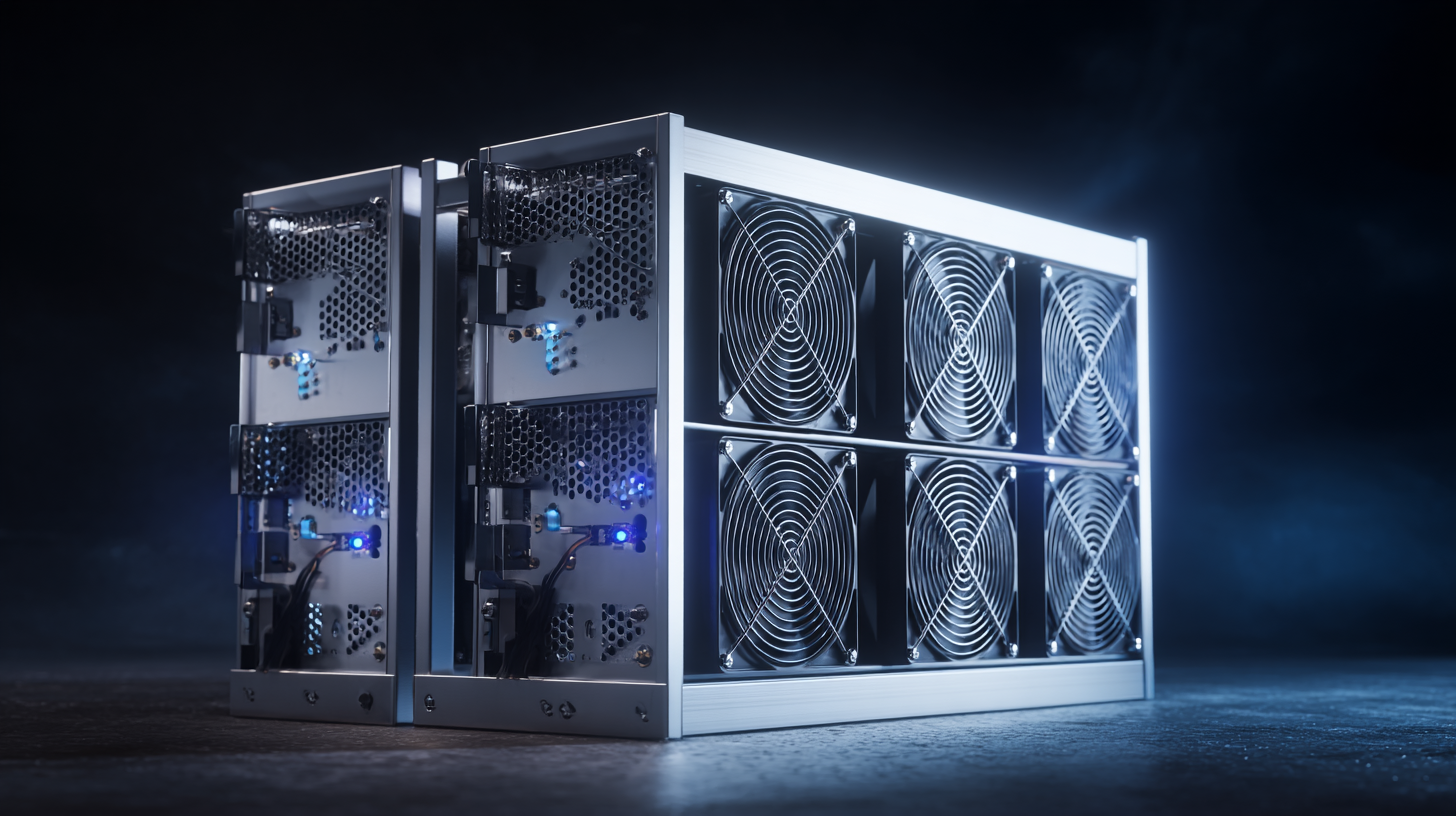Contact Us
2025 Top 5 Asic Crypto Miner Models Transforming the Cryptocurrency Mining Landscape
The cryptocurrency mining landscape is rapidly evolving, and one of the central components driving this transformation is the emergence of advanced ASIC Crypto Miner models. As reported by industry analysis from Statista, the global cryptocurrency market was valued at over $1.4 trillion in 2023, with mining activities accounting for a significant share of this growth. With the increasing complexity of mining algorithms and the quest for greater operational efficiency, ASIC (Application-Specific Integrated Circuit) miners have become the go-to hardware for serious miners aiming to maximize profitability.

Recent advancements in ASIC technology have resulted in models that not only provide higher hash rates but also consume less energy, thus addressing one of the most pressing challenges in the mining sector: sustainability. According to the Cambridge Centre for Alternative Finance, energy consumption in the mining industry has surged, making energy-efficient ASIC miners more critical than ever. By 2025, the top innovations in ASIC Crypto Miner models are expected to further revolutionize the sector, enhancing performance while aligning with the growing demand for environmentally responsible practices. In this regard, we will explore the top five ASIC Crypto Miner models that are poised to redefine the mining landscape in the coming years.
Top 5 ASIC Miners Revolutionizing Efficiency and Profitability in 2025
As the cryptocurrency mining landscape rapidly evolves, ASIC (Application-Specific Integrated Circuit) miners are at the forefront of this transformation. In 2025, the top five ASIC models are expected to revolutionize efficiency and profitability, driven by advancements in technology. For instance, according to a recent report by the Cambridge Centre for Alternative Finance, the energy efficiency of the latest ASIC models is projected to improve by over 50% compared to their predecessors. Miners are now able to achieve an unprecedented hash rate of 200 TH/s while consuming only 25 J/TH, significantly reducing operational costs.

Moreover, the growing integration of AI and machine learning within ASIC miners is enhancing the overall mining process. These technologies enable real-time monitoring and optimization of mining operations, which could lead to a predicted increase in profitability margins by up to 30% for miners utilizing the latest equipment. With the increased focus on sustainability, the development of miners powered by renewable energy sources is also set to gain traction. In fact, a market analysis by CoinGecko forecasts that over 30% of miners will shift towards eco-friendly models by 2025, further solidifying the role of advanced ASIC miners in a more efficient and profitable future for cryptocurrency mining.
Emerging Trends in ASIC Mining Technology for Cryptocurrency Enthusiasts
The world of ASIC mining technology is rapidly evolving, with significant innovations shaping the future of cryptocurrency mining in 2025.
Emerging trends demonstrate a notable shift towards more energy-efficient designs and enhanced hash power. According to a recent report from the Cambridge Centre for Alternative Finance, the efficiency of ASIC miners has improved by over 25% in the past two years, allowing miners to achieve higher output while reducing energy costs. This transformation makes mining more accessible and sustainable for both large-scale operations and individual enthusiasts.
As new ASIC models enter the market, they are equipped with advanced cooling systems and optimized chip architectures that prevent overheating and extend the lifetime of the devices. For cryptocurrency enthusiasts, it's essential to keep an eye on these developments, as they not only enhance profitability but also ensure minimal environmental impact.
Tips: When considering an ASIC miner purchase, research the performance metrics such as hash rate and power consumption. Additionally, always check for firmware updates from manufacturers, as these can significantly boost efficiency. Lastly, network with other miners to share insights about the latest trends and top-performing models in the market. Staying informed will help you make the best decisions for your mining operations.
Comparative Analysis of Performance Metrics in 2025's Best ASIC Miners
In 2025, the ASIC crypto mining landscape is expected to be dominated by models that exhibit exceptional performance metrics, significantly enhancing mining efficiency and profitability. According to a recent industry report by the Cambridge Centre for Alternative Finance, the average hash rate of top-performing ASIC miners has increased by over 50% compared to 2024, reaching up to 180 TH/s. This substantial boost in processing power allows miners to secure blocks faster and with reduced energy consumption, addressing the ongoing concerns regarding energy costs and environmental impact.
Moreover, advanced cooling technologies and optimization algorithms are being integrated into these machines, leading to an impressive reduction in power usage effectiveness (PUE). Data from the International Energy Agency (IEA) suggests that the most efficient ASIC miners now operate at a PUE of around 1.05, which is a significant improvement from the previous industry's average of 1.2. These innovations not only lower operational costs but also play a crucial role in sustaining competitive advantages within the rapidly evolving market. As miners seek to maximize returns in a landscape marked by volatility and stringent regulations, the performance metrics of these top models become indispensable for informed investment decisions.
Performance Metrics of Top 5 ASIC Crypto Miners in 2025
This chart compares the key performance metrics of the top 5 ASIC miners in 2025, focusing on hash rate, energy efficiency, and cost-effectiveness.
Energy Consumption Innovations in Next-Gen ASIC Miners: A Sustainable Approach
The cryptocurrency mining landscape is undergoing a significant transformation with the introduction of next-generation ASIC miners, focusing on energy consumption innovations. According to a recent report from the Cambridge Centre for Alternative Finance, energy usage in Bitcoin mining has surged, with estimates suggesting that it consumes as much electricity annually as the entire country of the Netherlands. In response, leading manufacturers are developing models that prioritize efficiency and sustainability, utilizing cutting-edge technologies to reduce energy consumption by up to 30%.
One standout innovation is the implementation of advanced cooling systems in ASIC miners, which enhance thermal efficiency and lower power usage. For instance, the latest models from Bitmain and MicroBT are incorporating immersion cooling technologies, which not only improve performance but also significantly cut down on energy costs. Research from the International Energy Agency indicates that the shift toward more energy-efficient mining technologies could potentially decrease the carbon footprint of the cryptocurrency sector significantly, aligning it with global sustainability goals. As these advancements continue to emerge, the mining industry is poised to become a more environmentally responsible player in the digital economy.

User Experience and Accessibility: How ASIC Miners are Evolving for Beginners
As the cryptocurrency mining landscape evolves, beginner-friendly ASIC miners are making it easier for newcomers to enter this once-complex field. Today, mining has transitioned from the days when anyone with a decent computer could mine Bitcoin at home to a more streamlined process that often requires sophisticated hardware and expertise. However, advancements in ASIC miner technology are bridging this gap, offering more accessible options for those unfamiliar with the nuances of mining.
The emergence of cloud mining platforms allows users to engage in Bitcoin mining without the need to manage physical hardware. This model significantly reduces the barriers to entry, enabling users to participate in mining simply by purchasing shares of powerful ASIC miners housed in professional data centers. As a result, beginners can now experience the benefits of mining while focusing on user-friendly interfaces and educational resources that accompany these services. With comprehensive beginner guides available, potential miners are better equipped to navigate the complexities of cryptocurrency, ensuring a more inclusive environment for all.
2025 Top 5 Asic Crypto Miner Models Transforming the Cryptocurrency Mining Landscape
| Model | Hash Rate (TH/s) | Power Consumption (W) | Price ($) | User Experience Rating (1-5) | Accessibility for Beginners |
|---|---|---|---|---|---|
| Model A | 110 TH/s | 3250 W | 2000 | 4.5 | High |
| Model B | 105 TH/s | 3000 W | 1800 | 4.0 | Medium |
| Model C | 95 TH/s | 2700 W | 1500 | 4.2 | High |
| Model D | 100 TH/s | 3400 W | 1700 | 3.8 | Low |
| Model E | 115 TH/s | 3100 W | 2200 | 4.7 | High |

